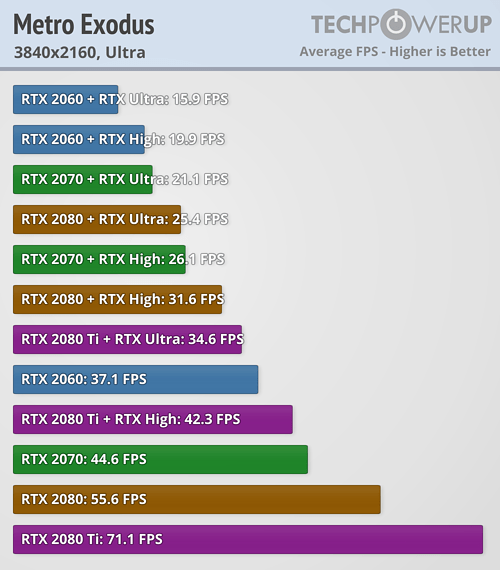 156
156
Metro Exodus Benchmark Performance, RTX & DLSS
Conclusion »Test System
| Test System | |
|---|---|
| Processor: | Intel Core i7-8700K @ 4.8 GHz (Coffee Lake, 12 MB Cache) |
| Motherboard: | ASUS Maximus X Code Intel Z370 |
| Memory: | G.SKILL 16 GB Trident-Z DDR4 @ 3866 MHz 18-19-19-39 |
| Storage: | 2x Patriot Ignite 960 GB SSD |
| Power Supply: | Antec HCP-1200 1200 W |
| Cooler: | Cryorig R1 Universal 2x 140 mm fan |
| Software: | Windows 10 64-bit October 2018 Update |
| Drivers: | NVIDIA: 417.22 WHQL (recommended by NVIDIA) AMD: Catalyst 19.2.1 Beta |
| Display: | Acer CB240HYKbmjdpr 24" 3840x2160 |
We used the press review version of Metro Exodus. We also used the latest drivers from NVIDIA and AMD, neither of which has a game ready driver available yet.
Graphics Memory Usage

Using a GeForce RTX 2080 Ti, which has 11 GB of VRAM, we tested the game's memory usage at the highest settings.
VRAM usage at Ultra can be described as "acceptable" for lower resolutions, with 3 GB at 1080p. Every recent graphics card from this segment should be able to handle memory requirements. For higher resolutions, memory requirements are very modest—all modern graphics cards that can drive these resolutions have 8 GB of VRAM or more.
It's interesting to see that enabling RTX has a constant, resolution-independent VRAM cost of around 1 GB, which can be explained by the additional memory consumed by the data structures to store the geometry, which are used to accelerate ray-testing.
Enabling DLSS only adds another 250 MB of VRAM use, which is pretty much negligible.
GPU Performance



RTX Raytracing Performance



Apr 25th, 2024 21:14 EDT
change timezone
Latest GPU Drivers
New Forum Posts
- TPU's Nostalgic Hardware Club (18465)
- Post your Speedometer 3.0 Score (36)
- Size on Disk Excessively Different than Size (9)
- Dell Workstation Owners Club (3056)
- Core PL1 + GPU PL1 + Ring EDP OTHER (10)
- Best SSD for system drive (80)
- Which new games will you be buying? (315)
- BSOD if I touch the pcache offset voltage in throttlestop (i9-13900hx lenovo pro 7i) (23)
- Alphacool CORE 1 CPU block - bulging with danger of splitting? (16)
- How to check flatness of CPUs and coolers - INK and OPTICAL INTERFERENCE methods (112)
Popular Reviews
- Fractal Design Terra Review
- Thermalright Phantom Spirit 120 EVO Review
- Corsair 2000D Airflow Review
- ASUS GeForce RTX 4090 STRIX OC Review
- NVIDIA GeForce RTX 4090 Founders Edition Review - Impressive Performance
- ASUS GeForce RTX 4090 Matrix Platinum Review - The RTX 4090 Ti
- MSI GeForce RTX 4090 Suprim X Review
- Gigabyte GeForce RTX 4090 Gaming OC Review
- MSI GeForce RTX 4090 Gaming X Trio Review
- MSI GeForce RTX 4090 Suprim Liquid X Review
Controversial News Posts
- Sony PlayStation 5 Pro Specifications Confirmed, Console Arrives Before Holidays (117)
- Windows 11 Now Officially Adware as Microsoft Embeds Ads in the Start Menu (107)
- NVIDIA Points Intel Raptor Lake CPU Users to Get Help from Intel Amid System Instability Issues (106)
- AMD "Strix Halo" Zen 5 Mobile Processor Pictured: Chiplet-based, Uses 256-bit LPDDR5X (101)
- US Government Wants Nuclear Plants to Offload AI Data Center Expansion (98)
- AMD's RDNA 4 GPUs Could Stick with 18 Gbps GDDR6 Memory (88)
- Developers of Outpost Infinity Siege Recommend Underclocking i9-13900K and i9-14900K for Stability on Machines with RTX 4090 (85)
- Windows 10 Security Updates to Cost $61 After 2025, $427 by 2028 (84)